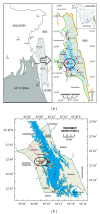Traditional knowledge and formulations of medicinal plants used by the traditional medical practitioners of bangladesh to treat schizophrenia like psychosis
- PMID: 25101175
- PMCID: PMC4100298
- DOI: 10.1155/2014/679810
Traditional knowledge and formulations of medicinal plants used by the traditional medical practitioners of bangladesh to treat schizophrenia like psychosis
Abstract
Schizophrenia is a subtle disorder of brain development and plasticity; it affects the most basic human processes of perception, emotion, and judgment. In Bangladesh the traditional medical practitioners of rural and remote areas characterized the schizophrenia as an insanity or a mental problem due to possession by ghosts or evil spirits and they have used various plant species' to treat such symptoms. The aim of the present study was to conduct an ethnomedicinal plant survey and documentation of the formulations of different plant parts used by the traditional medical practitioners of Rangamati district of Bangladesh for the treatment of schizophrenia like psychosis. It was observed that the traditional medical practitioners used a total of 15 plant species to make 14 formulations. The plants were divided into 13 families, used for treatment of schizophrenia and accompanying symptoms like hallucination, depression, oversleeping or insomnia, deterioration of personal hygiene, forgetfulness, and fear due to evil spirits like genies or ghost. A search of the relevant scientific literatures showed that a number of plants used by the medicinal practitioners have been scientifically validated in their uses and traditional medicinal knowledge has been a means towards the discovery of many modern medicines. Moreover, the antipsychotic drug reserpine, isolated from the dried root of Rauvolfia serpentina species, revolutionized the treatment of schizophrenia. So it is very much possible that formulations of the practitioner, when examined scientifically in their entireties, can form discovery of lead compounds which can be used as safe and effective antipsychotic drug to treat schizophrenia.
Figures
Similar articles
-
A narrative review of the ethnomedicinal usage of Cannabis sativa Linnaeus as traditional phytomedicine by folk medicine practitioners of Bangladesh.J Cannabis Res. 2021 Mar 19;3(1):8. doi: 10.1186/s42238-021-00063-3. J Cannabis Res. 2021. PMID: 33741060 Free PMC article. Review.
-
Ethnopharmacological survey of medicinal plants used by indigenous and tribal people in Rangamati, Bangladesh.J Ethnopharmacol. 2012 Dec 18;144(3):627-37. doi: 10.1016/j.jep.2012.10.003. Epub 2012 Oct 11. J Ethnopharmacol. 2012. PMID: 23064284
-
A pharmacological and phytochemical evaluation of medicinal plants used by the Harbang clan of the Tripura tribal community of Mirsharai area, Chittagong district, Bangladesh.J Altern Complement Med. 2010 Jul;16(7):769-85. doi: 10.1089/acm.2009.0497. J Altern Complement Med. 2010. PMID: 20590477
-
A survey of medicinal plants used by Kavirajes of Chalna area, Khulna district, Bangladesh.Afr J Tradit Complement Altern Med. 2009 Dec 30;7(2):91-7. doi: 10.4314/ajtcam.v7i2.50859. Afr J Tradit Complement Altern Med. 2009. PMID: 21304618 Free PMC article.
-
Genus Rauvolfia: A review of its ethnopharmacology, phytochemistry, quality control/quality assurance, pharmacological activities and clinical evidence.J Ethnopharmacol. 2022 Sep 15;295:115327. doi: 10.1016/j.jep.2022.115327. Epub 2022 Apr 30. J Ethnopharmacol. 2022. PMID: 35504505 Review.
Cited by
-
Appraisals of Bangladeshi Medicinal Plants Used by Folk Medicine Practitioners in the Prevention and Management of Malignant Neoplastic Diseases.Int Sch Res Notices. 2016 Jan 14;2016:7832120. doi: 10.1155/2016/7832120. eCollection 2016. Int Sch Res Notices. 2016. PMID: 27382642 Free PMC article.
-
A narrative review of the ethnomedicinal usage of Cannabis sativa Linnaeus as traditional phytomedicine by folk medicine practitioners of Bangladesh.J Cannabis Res. 2021 Mar 19;3(1):8. doi: 10.1186/s42238-021-00063-3. J Cannabis Res. 2021. PMID: 33741060 Free PMC article. Review.
-
Association of NOTCH4 and CYP2E1 Genetic Variants With Schizophrenia in the Bangladeshi Population: A Case-Control Study.Health Sci Rep. 2024 Dec 17;7(12):e70262. doi: 10.1002/hsr2.70262. eCollection 2024 Dec. Health Sci Rep. 2024. PMID: 39698532 Free PMC article.
-
Prevalence and Drivers of Self-Medication Practices among Savar Residents in Bangladesh: A Cross-Sectional Study.Risk Manag Healthc Policy. 2020 Jul 8;13:743-752. doi: 10.2147/RMHP.S256272. eCollection 2020. Risk Manag Healthc Policy. 2020. PMID: 32753987 Free PMC article.
-
Identification of novel amides and alkaloids as putative inhibitors of dopamine transporter for schizophrenia using computer-aided virtual screening.Front Pharmacol. 2025 Apr 8;16:1509263. doi: 10.3389/fphar.2025.1509263. eCollection 2025. Front Pharmacol. 2025. PMID: 40303924 Free PMC article.
References
-
- Hodgins S. Mental disorder, intellectual deficiency, and crime: evidence from a birth cohort. Archives of General Psychiatry. 1992;49(6):476–483. - PubMed
-
- Hodgins S, Mednick SA, Brennan PA, Schulsinger F, Engberg M. Mental disorder and crime: evidence from a Danish birth cohort. Archives of General Psychiatry. 1996;53(6):489–496. - PubMed
-
- Gottesman II. Schizophrenia Genesis: The Origin of Madness. New York, NY, USA: Freeman; 1991.
-
- Perälä J, Suvisaari J, Saarni SI, et al. Lifetime prevalence of psychotic and bipolar I disorders in a general population. Archives of General Psychiatry. 2007;64(1):19–28. - PubMed
-
- Murray CJL, Lopez AD, editors. The Global Burden of Disease. A Comprehensive Assessment of Mortality and Disability from Diseases, Injuries, and Risk Factors in 1990 and Projected to 2020. Cambridge, Mass, USA: Harvard School of Public Health; 1996.
LinkOut - more resources
Full Text Sources
Other Literature Sources



